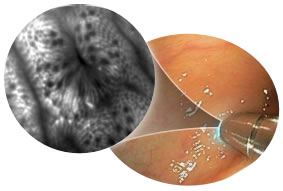Colorectal NeoplasiaStreamlining colorectal cancer screening
During standard colonoscopy procedures, physicians remove all polyps and send them to a pathologist for analysis. This can substantially increase endoscopic workload, pathology costs and potential complications for the patient, while it is estimated that 25 to 50% of these polyps are hyperplastic.
Probe-based Confocal Laser Endomicroscopy (pCLE) with the Cellvizio® system can magnify a polyp by a factor of 1,000 to help a physician detect cellular-level features that differentiate adenomatous from non-adenomatous colorectal polyps during the colonoscopy procedure in real time. With the additional information provided by the ColoFlex™ miniprobe, the physician can use his/her medical judgment to either leave the polyp or remove it and send it for pathological analysis or just discard it.

In the March 2010 issue of Gastroenterology, researchers at the Mayo Clinic in Jacksonville, Florida, reported that Cellvizio® was 91 percent accurate in detecting precancerous polyps and narrow-band imaging was 77 percent accurate, when compared to biopsy findings. The authors concluded that for lesions clearly deemed hyperplastic with Cellvizio®, “the lesion could be left in situ.”
This study confirmed previous results reported by other teams. In a recent review presentation at the Amsterdam Live Endoscopy 2009 course, Prof. Michael Wallace (Mayo Clinic, Jacksonville, Fl) summarized previous studies showing Cellvizio® as an effective tool for the classification of colorectal polyps in situ.
Physicians are also using Cellvizio® during follow-up colonoscopies to re-examine polyp resection sites to determine if re-treatment is necessary. A recent study performed by researchers at Mayo Clinic in Florida and the Academic Medical Center in Amsterdam has shown a sensitivity of 100% for the detection of residual dysplasia versus 63% with narrow-band imaging and a Negative Predictive Value of 100%. Presentations on this key subject will take place at the upcoming Digestive Disease Week conference to be held in May, 2010 in New Orleans.
The Mayo Clinic group has evaluated the learning curve of Cellvizio® probe-based Confocal Laser Endomicroscopy (pCLE) for colorectal polyps and found that new users rapidly acquired the ability to interpret pCLE images with accuracy similar to highly experienced experts. New users were able to interpret images with an accuracy of 93% after reading at least 35 cases.
MORE
• GastroFlex™ UHD for Eso-Gastro-Duodenoscopy (EGD)
• CholangioFlex™ for Endoscopic Retrograde Cholangio-Pancreatography (ERCP)
• AQ-Flex™ 19 for Endoscopic Ultrasound-Guided Fine Needle Aspiration (EUS-FNA)
• ColoFlex™ UHD for Colonoscopy
• AlveoFlex™ for Bronchoscopy and Alveoscopy
|

